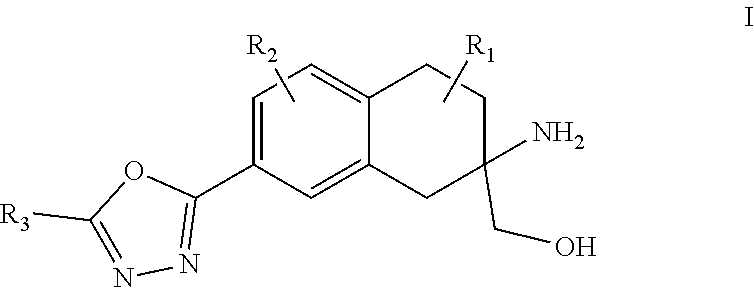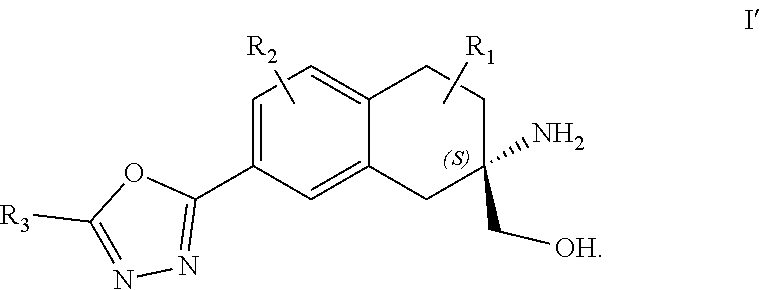Amino alcohol derivative, pharmaceutical composition and application thereof
a technology of amino alcohol and composition, applied in the field of medicine, can solve the problems of reducing affecting the anti-infection ability of patients, and affecting the immune system, so as to achieve effective targeting, and reduce the effect of immune system malfunction
- Summary
- Abstract
- Description
- Claims
- Application Information
AI Technical Summary
Benefits of technology
Problems solved by technology
Method used
Image
Examples
preparation example 1
[0128]
[0129]Synthesis of Intermediate 2
[0130]100 g (465 mmol) of compound 1 was dissolved in 500 ml of dichloromethane, cooled to 0° C. in ice-salt bath, and added dropwise with 120 g (930 mmol) of oxalyl chloride. After the dropping was finished, the mixture obtained was heated at reflux and reacted for 2 h. The reaction was monitored by TLC. After the reaction was completed, the solvent was evaporated to dryness, and dichloromethane was added and evaporated to dryness again to afford 112 g of intermediate, as a yellow liquid which was used directly in the next step. 210 g (1410 mmol) of aluminum chloride was suspended in 400 ml of dichloromethane, cooled to −10° C. to −5° C., and then added dropwise with a solution of 112 g of the above intermediate in 100 ml of dichloromethane. After the dropping was finished, ethylene gas was introduced into the reaction system for about 2 h keeping the temperature of −10° C. to −5° C. After TLC showed that the reaction was completed, the reacti...
example 1 (
S)-(2-amino-7-(5-(3-fluoro-4-isopropoxyphenyl)-1,3,4-oxadiazol-2-yl)-1,2,3,4-tetrahydronaphthalen-2-yl)methanol
[0155]
[0156]0.6 g (1.24 mmol) of intermediate 23 was dissolved in 13 ml of methanol, added with 0.01 ml of concentrated hydrochloric acid, purged with nitrogen to remove air, followed by the addition of 0.122 g (20% m / m) of palladium 10% on carbon, purged with hydrogen, and reacted for 240 min at 95° C. The reaction was monitored by TLC (DCM:MeOH=10:1). After the reaction was completed, the resulting mixture was filtered, and the filter cake was washed with plenty of methanol. The filtrate was concentrated by rotary evaporation, added with 30 ml of saturated sodium bicarbonate solution and 30 ml of dichloromethane, stirred, allowed to stand and separated into layers. The aqueous phase was extracted with dichloromethane. The organic phases were combined, dried, filtered and rotary evaporated to give a crude product, which was purified with silica gel column (eluent: DCM:MeOH...
preparation example 2
[0157]Synthesis of Intermediate 27
[0158]2.0 g (12 mmol) of intermediate 26 was dissolved in 20 ml of methanol, cooled to 0° C., added dropwise with 2.6 ml (36 mmol) of thionyl chloride, warmed to room temperature, stirred and reacted overnight. The reaction was monitored by TLC. After the reaction was completed, the reaction solution was adjusted to pH 8 with saturated sodium bicarbonate solution, and rotary evaporated to dryness to remove methanol. The aqueous phase was extracted with dichloromethane. The organic phases were combined, dried and rotary evaporated to dryness to give a product (1.9 g) as a white solid. Yield: 81.67%.
[0159]Synthesis of Intermediate 28
[0160]Under the protection of nitrogen, 1.911 g (9.8 mmol) of intermediate 27 was dissolved in 7 g (118.7 mmol, 85%) of hydrazine hydrate, heated to 85° C. and reacted for 7 h. The reaction was monitored by TLC. After the reaction was completed, the resulting mixture was cooled to room temperature, filtered and pumped to d...
PUM
| Property | Measurement | Unit |
|---|---|---|
| temperature | aaaaa | aaaaa |
| temperature | aaaaa | aaaaa |
| temperature | aaaaa | aaaaa |
Abstract
Description
Claims
Application Information
 Login to View More
Login to View More - R&D
- Intellectual Property
- Life Sciences
- Materials
- Tech Scout
- Unparalleled Data Quality
- Higher Quality Content
- 60% Fewer Hallucinations
Browse by: Latest US Patents, China's latest patents, Technical Efficacy Thesaurus, Application Domain, Technology Topic, Popular Technical Reports.
© 2025 PatSnap. All rights reserved.Legal|Privacy policy|Modern Slavery Act Transparency Statement|Sitemap|About US| Contact US: help@patsnap.com



